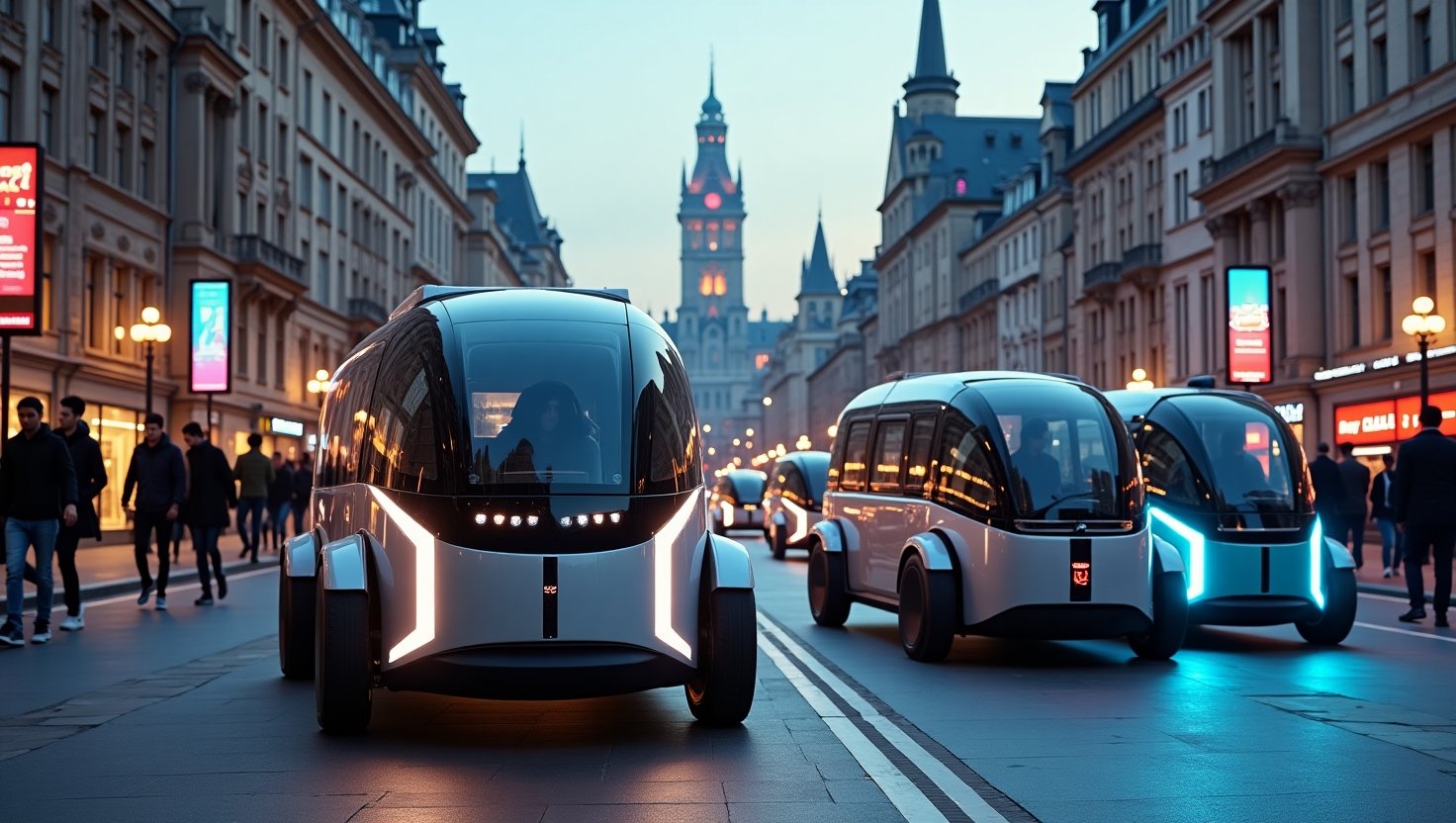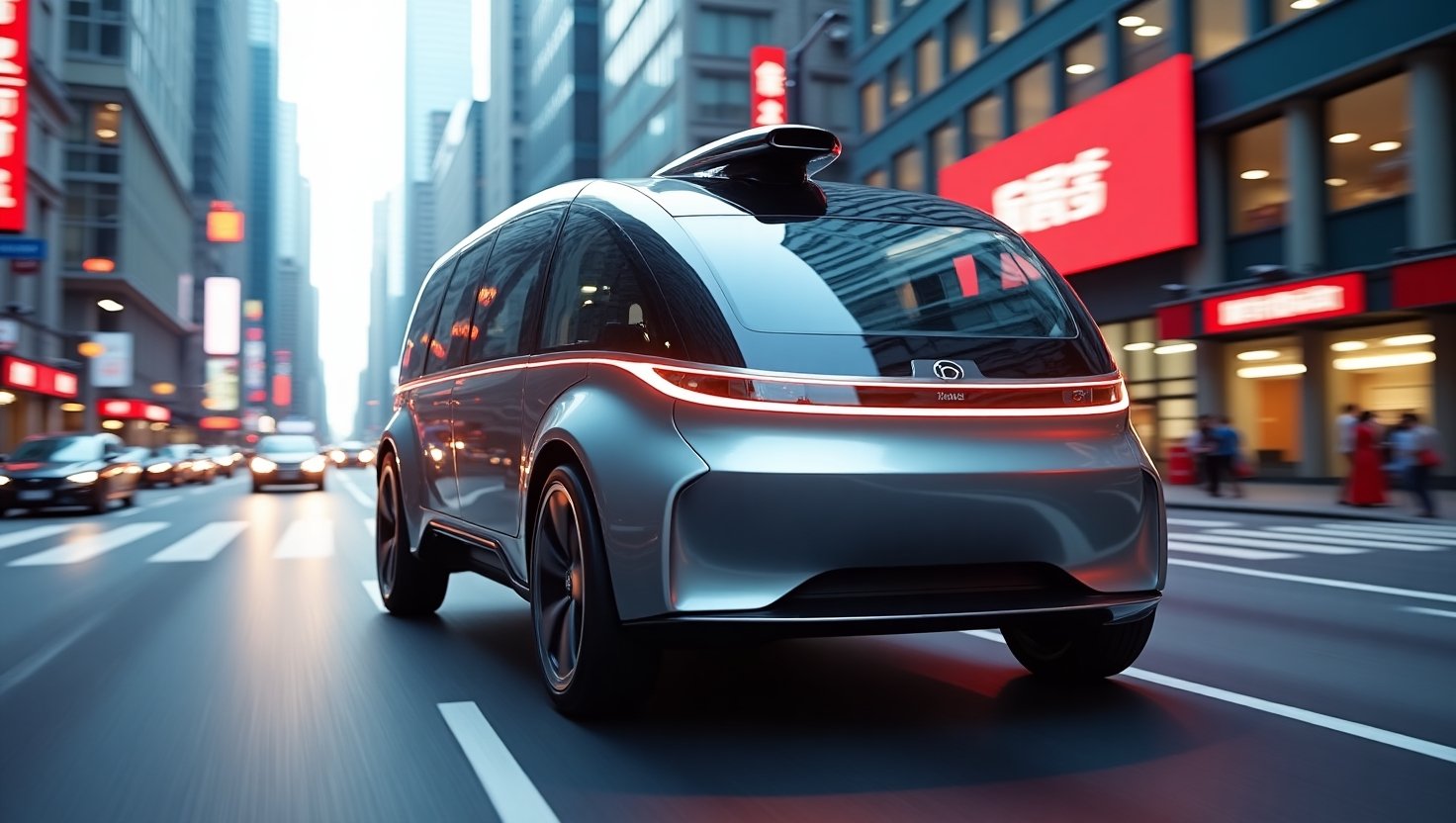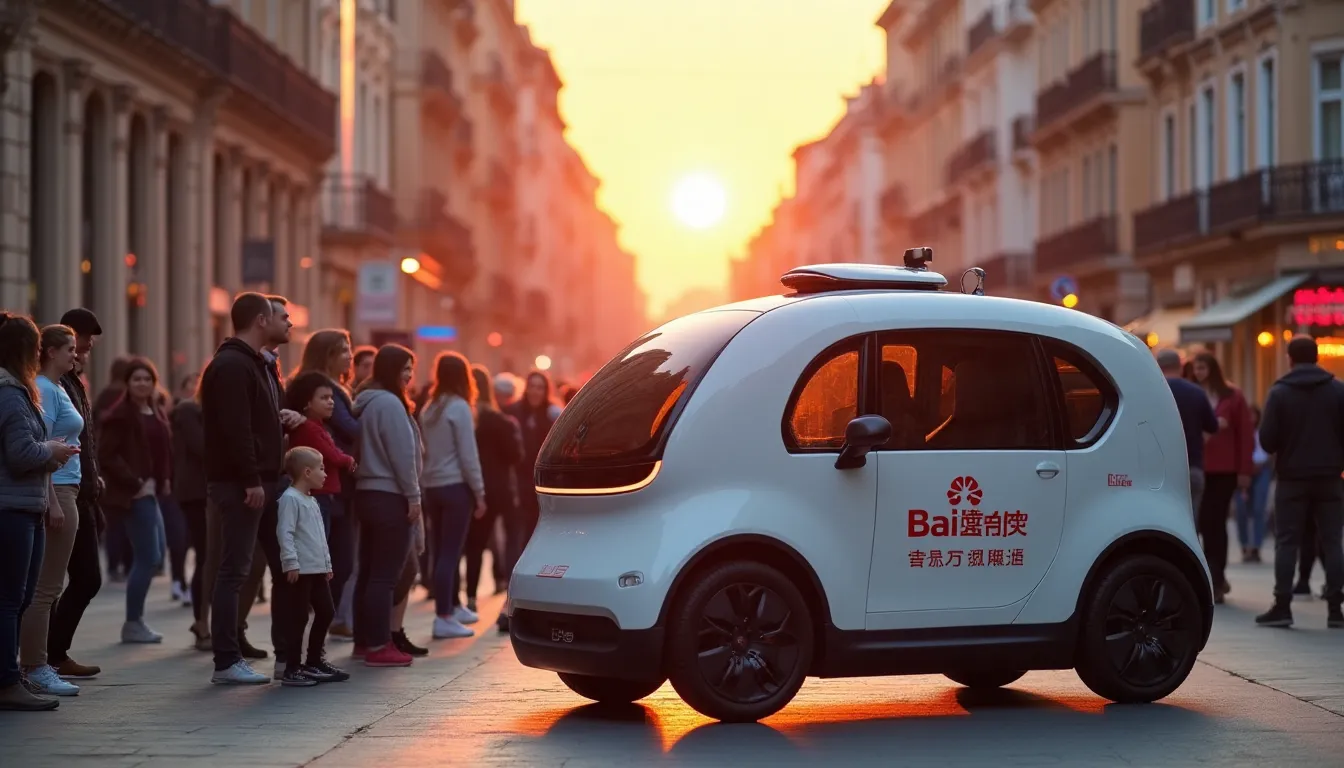In a groundbreaking move that could redefine transportation in Europe, Lyft has teamed up with China’s Baidu to introduce robotaxis to the continent by 2026. This partnership signals a significant step forward in the deployment of autonomous vehicles, as it aims to integrate Baidu’s Apollo Go robotaxi services within Lyft’s established ride-hailing platform.
As both companies navigate the intricate landscape of regulatory approvals, the introduction of robotaxis not only represents innovation in urban mobility but also showcases a fierce commitment to harnessing technology that promises greater efficiency and convenience for riders.
With the potential to transform how people access transportation, this collaboration between Lyft and Baidu highlights the exciting future of autonomous vehicles in Europe, setting a precedent for upcoming developments in the sector.


Lyft and Baidu Partnership
In an ambitious collaboration, Lyft and Baidu aim to introduce Baidu’s autonomous vehicles, specifically the RT6 models, into Lyft’s ride-hailing ecosystem across Europe by 2026, pending necessary regulatory approvals. This partnership not only marks a significant technological advancement in the ride-hailing industry but also sets the stage for a transformed mobility landscape in countries like Germany and the United Kingdom.
Integration of Autonomous Vehicles
Baidu’s RT6 vehicles, known for their cutting-edge autonomous driving technology, will be seamlessly integrated into Lyft’s existing app. This integration will allow Lyft to offer a robust robotaxi service to customers, combining the convenience of Lyft’s platform with the innovative capability of Baidu’s autonomous technologies. By leveraging Baidu’s expertise in self-driving systems through its Apollo Go platform, Lyft can tap into the growing demand for autonomous ride-hailing services.
Hybrid Network Approach
The partnership also embodies Lyft’s hybrid network approach, which is designed to enhance customer experiences by combining autonomous vehicles and human drivers. This strategy promises a more versatile ride-hailing service, as it allows riders to choose between a robotaxi and a traditional human-driven car based on their preferences or availability. Lyft CEO David Risher emphasized that this model aims to provide customer-obsessed options for riders, creating a responsive transportation model that can cater to diverse needs.
Timeline and Regulatory Conditions
As Lyft and Baidu prepare for the rollout, they face significant regulatory hurdles typical of deploying autonomous vehicles. Both companies are working diligently to meet the requirements set forth by European authorities, aiming for deployment by 2026. The successful introduction of the RT6 robotaxis is expected to not only enhance the ride-hailing experience but also contribute to reducing traffic congestion and carbon emissions in urban areas.
This strategic alliance between Lyft and Baidu marks a pivotal moment in the evolution of ride-hailing services in Europe, with the potential to redefine how urban mobility is perceived and implemented, setting a high standard for innovation in future transportation solutions.
| Service Provider | Features | Vehicle Types | Geographic Areas Served | Unique Selling Propositions |
|---|---|---|---|---|
| Lyft + Baidu | Integration with ride-hailing app | Baidu RT6 | Germany, United Kingdom | Hybrid network approach combining AVs and human drivers |
| Uber | On-demand ride services | Various (including SUVs) | Global | Strong existing market presence and app user base |
| FREENOW | Ride-hailing and taxi services | Various (including EVs) | Europe | Strong partnerships with local taxi services |
| May Mobility | Autonomous shuttles, on-demand rides | Various electric vehicles | Selected cities in the U.S. | Focus on customizable shuttle services for specific routes |
| BMW | Premium ride experience | BMW electric vehicles | Selected cities globally | Luxury vehicle experience with automated driving tech |
| Mercedes-Benz | Automated ride-hailing services | Mercedes electric vehicles | Selected international cities | Focus on premium customer experience and safety features |
| Volkswagen | City-based autonomous vehicle solutions | Various electric vehicles | Europe, U.S. | Focus on shared mobility and emissions reduction strategies |
| Service Provider | Features | Vehicle Types | Geographic Areas Served | Unique Selling Propositions |
|---|---|---|---|---|
| Lyft + Baidu | Integration with ride-hailing app | Baidu RT6 | Germany, United Kingdom | Hybrid network approach combining AVs and human drivers |
| Uber | On-demand ride services | Various (including SUVs) | Global | Strong existing market presence and app user base |
| FREENOW | Ride-hailing and taxi services | Various (including EVs) | Europe | Strong partnerships with local taxi services |
| May Mobility | Autonomous shuttles, on-demand rides | Various electric vehicles | Selected cities in the U.S. | Focus on customizable shuttle services for specific routes |
| BMW | Premium ride experience | BMW electric vehicles | Selected cities globally | Luxury vehicle experience with automated driving tech |
| Mercedes-Benz | Automated ride-hailing services | Mercedes electric vehicles | Selected international cities | Focus on premium customer experience and safety features |
| Volkswagen | City-based autonomous vehicle solutions | Various electric vehicles | Europe, U.S. | Focus on shared mobility and emissions reduction strategies |
User Adoption Statistics for Robotaxis and Autonomous Vehicles in Europe
As the initiative by Lyft and Baidu moves closer to reality, recent statistics indicate favorable trends towards the adoption of robotaxis in key European markets like Germany and the UK.
Germany:
- Legislative Support: Germany’s new laws permit Level 4 autonomous vehicles to operate on public roads. This regulatory framework is a vital step for companies looking to deploy robotaxi services.
- Market Growth Predictions: The market for robotaxis in Germany is projected to explode from approximately $2.56 million in revenue in 2022 to about $1.8 billion by 2030, indicating a compound annual growth rate (CAGR) of around 73% (Cognitive Market Research).
United Kingdom:
- Legal Framework for Autonomous Vehicles: The UK’s “Automated Vehicles Act 2024” is paving the way for the operation of fully autonomous vehicles, which is crucial for the launch of robotaxi services.
- Market Projections: The UK robotaxi market is similarly expected to surge, with projections showing sales revenue rising from $2.21 million in 2022 to an estimated $1.5 billion by 2030, leading to a CAGR of roughly 72% (Cognitive Market Research).
Broader Trends:
- Adoption and Fleet Expansion: Germany and the UK together are anticipated to have over 100,000 robotaxis operational by 2030 (PatentPC).
- Public Perception: While legislative advancements are supportive, public perception presents a hurdle. A 2024 YouGov poll indicates that 37% of UK residents are unwilling to travel in a driverless car (Tech Informed).
These trends suggest a strong market potential for Lyft and Baidu’s robotaxi venture as regulatory landscapes evolve and public acceptance gradually increases, indicating a shift towards embracing autonomous vehicles in urban mobility.
User Adoption Statistics for Robotaxis and Autonomous Vehicles in Europe
The initiative by Lyft and Baidu is set against a backdrop of increasingly favorable conditions for the adoption of robotaxis in key European markets such as Germany and the UK.
Germany:
- Legislative Support: Germany has enacted a progressive regulatory framework allowing Level 4 autonomous vehicles to operate on public roads. The “Federal Act Amending the Road Traffic Act” passed in July 2021 allows for the legal operation of fully autonomous vehicles under strict safety guidelines (Wikipedia).
- Market Growth Predictions: The autonomous vehicle market in Germany is projected to grow significantly, from approximately USD 3.57 billion in 2023 to USD 12.03 billion by 2030, with a compound annual growth rate (CAGR) of 19% (Grand View Research).
United Kingdom:
- Legal Framework: The UK has similarly implemented the “Automated and Electric Vehicles Act 2018” which lays the groundwork for the integration of fully autonomous vehicles. The government has initiated trials in cities like London, fostering a supportive environment for innovation and development (Wikipedia).
- Market Projections: The UK robotaxi market is expected to experience one of the highest growth rates in Europe, projecting sales revenue to increase from USD 2.21 million in 2022 to an estimated USD 1.5 billion by 2030, reflecting a CAGR roughly around 72% (SkyQuest).
Public Perception and Challenges:
- While the legislative framework is encouraging, public acceptance remains a challenge. According to a YouGov poll conducted in 2024, 37% of respondents in the UK expressed they would feel unsafe traveling in a driverless car (Tech Informed).
- However, exposure to autonomous vehicle technology in trials shows promise for increasing acceptance over time. Regions with existing autonomous vehicle operations in the U.S. report a decline in safety concerns as public familiarity grows (Tech Informed).
In summary, both Germany and the UK are witnessing significant progress and investment in the development of robotaxis and autonomous vehicles, encouraged by favorable regulatory conditions. However, overcoming public hesitance toward autonomous transport will be pivotal in fully realizing the potential of these technologies in urban mobility.
In conclusion, the partnership between Lyft and Baidu marks a significant milestone in revolutionizing urban mobility across Europe with the introduction of robotaxi services. By integrating Baidu’s innovative RT6 vehicles into Lyft’s ride-hailing platform, both companies are poised to set the standard for the future of transportation in major markets like Germany and the United Kingdom.
This collaboration emphasizes the pivotal role that regulatory approval and technological advancements will play in successfully launching autonomous vehicle services. As policymakers pave the way for the legal operation of such services, the expected benefits include enhanced mobility options for urban residents, reduced congestion, and lower emissions.
Looking ahead, the interplay of regulatory frameworks and groundbreaking technology will be crucial in overcoming challenges and ensuring that robotaxis become a reliable and accepted means of transport within European cities. With the commitment to innovation deeply embedded in this partnership, the landscape of urban mobility is on the cusp of a transformative shift, heralding new possibilities for how we travel and interact within our communities.
Regulatory Challenges for Lyft and Baidu in Deploying Robotaxis in Europe
As Lyft and Baidu embark on their ambitious project to launch robotaxis in Europe by 2026, they must navigate a complex web of regulatory challenges that could significantly impact their timelines and project viability. These challenges are not just bureaucratic hurdles but are fundamental in ensuring public safety, fostering technological innovation, and gaining public trust.
Understanding the Regulatory Landscape
European regulations governing autonomous vehicles are substantial and varied by country. In Germany, for example, the legal framework has begun to support Level 4 autonomous vehicles, allowing for their operation under strict conditions. According to the “Federal Act Amending the Road Traffic Act,” which passed in July 2021, companies must adhere to rigorous safety and operational protocols before deploying self-driving vehicles on public roads. Similarly, the UK has integrated the “Automated Vehicles Act 2024,” which lays the groundwork for fully autonomous vehicles but also mandates thorough testing and compliance with defined safety measures.
Importance of Compliance
Compliance with these regulations is paramount for Lyft and Baidu, as non-compliance could lead to severe repercussions, including fines, project delays, or even bans on operations. Lyft’s CEO David Risher emphasized that “the robotaxi service is an example of its hybrid network approach, where AVs and human drivers work together to provide customer-obsessed options for riders.” This highlights the importance of maintaining a balance between innovation and adherence to regulations, ensuring that both technological advancements and safety are prioritized.
Funding for research and development in regulatory compliance can also be significant. Informed projections indicate that a substantial portion of the operational budget may be allocated to navigating these regulations effectively.
Impact on Project Timeline and Viability
The timeline for rolling out robotaxi services in Europe could be affected drastically by the pace at which regulations are finalized and implemented. While both countries are initiating favorable frameworks, actual deployment hinges upon successful navigation through approval processes at both local and national levels. Experts warn that delays in licensing, safety inspections, and adherence to regulatory updates can lead to postponements in timelines that are already ambitious.
“Understanding and adapting to the regulatory environment will be crucial for Lyft and Baidu to not only launch their services but to sustain them amid changing public sentiments and technological advancements,” noted a spokesperson from the European Mobility Agency. This highlights the need for a proactive approach in engaging with regulators and stakeholders to foster a cooperative environment.
Conclusion
In summary, as Lyft and Baidu work towards introducing their robotaxi services, the regulatory challenges they face are inherently intertwined with their overall success. By prioritizing regulatory compliance and engaging with European authorities, they can not only adhere to necessary legal frameworks but also pave the way for a more widespread acceptance of autonomous vehicles among the general public. The road to deployment by 2026 may be fraught with challenges, but with a strategic and compliant approach, Lyft and Baidu can lead the charge in transforming urban mobility in Europe.
Baidu’s RT6 Vehicles: A Leap Towards Autonomous Robotaxi Services
Baidu’s RT6 vehicles represent a technological leap in the realm of autonomous driving, particularly tailored for the robotaxi service. Equipped with Level 4 autonomous driving capabilities, the RT6 is engineered to navigate without human intervention in defined areas, making it an ideal candidate for urban transportation systems. The vehicle integrates sophisticated technologies including 38 sensors, which comprise 8 LiDAR units and 12 cameras. This array of sensors provides a comprehensive 360-degree view of the vehicle’s surrounding environment, allowing it to safely traverse complex urban landscapes ([prnewswire.com]).
Moreover, the RT6 features a detachable steering wheel. This design innovation expands the internal layout, facilitating adaptability for various passenger needs, such as additional seating or even amenities like vending machines and gaming consoles ([prnewswire.com]). Such flexibility not only enhances the comfort of users but also transforms the ride-sharing experience into a more engaging one.
In August 2025, Lyft and Baidu announced their partnership to introduce RT6 robotaxis across Europe, primarily targeting the German and UK markets by 2026, contingent on regulatory approvals. Under this agreement, Lyft will handle customer service and fleet operations, leveraging Baidu’s state-of-the-art autonomous vehicle technology to offer an efficient robotaxi experience ([reuters.com]).
The integration of Baidu’s RT6 vehicles into Lyft’s platform is poised to revolutionize user experience significantly. Passengers will benefit from enhanced safety features, effective route optimization, and cost efficiencies, as Baidu’s initiatives suggest that robotaxi fares could become half of traditional taxi costs. This economic model aims to democratize access to autonomous transportation, making it a viable option for a broader demographic ([prnewswire.com]).
In summary, Baidu’s RT6 not only sets a new standard for autonomous vehicles but also integrates seamlessly with existing ride-hailing infrastructures like Lyft, enhancing user satisfaction while pushing the envelope on technological innovation in urban mobility.

Closing Thoughts on Urban Mobility
The introduction of robotaxis, particularly through the collaboration of Lyft and Baidu, marks an important transformative chapter in urban mobility. This partnership opens the door to a future in which transportation is not only more efficient but also more accessible for a diverse range of urban residents. As companies converge to harness cutting-edge technology, this trend underscores the necessity for collaboration in driving innovation within the sector.
Furthermore, the implications of deploying robotaxi services extend beyond convenience; they present significant opportunities for sustainability. By potentially reducing the number of conventional vehicles on the road, the adoption of robotaxis could contribute to lower emissions and a more environmentally friendly urban landscape. This aligns well with global goals for carbon reduction and sustainable urban living.
The evolution of ride-hailing services indicates a potential shift toward more varied transportation options tailored to meet evolving consumer demands. As robotaxis become a mainstream choice, urban areas may witness improved transportation networks that accommodate diverse mobility needs ranging from budget-friendly to premium services.
Looking ahead, the landscape of urban planning could be substantially reshaped by the integration of autonomous vehicles. Smart city designs might emerge, emphasizing pathways that prioritize not just human convenience but also the operational efficiencies of robotaxis. This evolution creates a unique synergy where technology and urban design come together, fostering interconnected communities and redefining how transportation networks are conceptualized and deployed.
In conclusion, the collaboration between Lyft and Baidu on robotaxis heralds a significant shift towards smarter, more sustainable urban mobility solutions. As these technologies emerge and mature, they will undoubtedly inspire fresh approaches to city living and transportation models, encouraging us all to rethink how we move within our urban environments.
Competitive Landscape of Robotaxi Services
The robotaxi landscape is rapidly evolving, characterized by fierce competition among established players, innovative startups, and technological collaborations. Major competitors in this sphere include Lyft, Baidu, Uber, FREENOW, May Mobility, Mercedes-Benz, and Volkswagen, each pursuing unique strategies to capture market share and innovate within the autonomous vehicle space.
Lyft and Baidu Partnership
The partnership between Lyft and Baidu represents a strategic leap towards deploying autonomous vehicle services across Europe, with aims to launch in Germany and the UK by 2026. Lyft leverages Baidu’s advanced RT6 robotaxi technology, further enhanced by integrating this service into its existing ride-hailing platform. This strategic collaboration not only signals Baidu’s entry into the European market but also supports Lyft’s acquisition of FREENOW, positioning it for competitive advantage in the European mobility sector. The partnership highlights Lyft’s hybrid network approach that combines autonomous vehicles (AVs) and human drivers to provide optimized service options to customers.
Uber’s Autonomous Initiatives
Uber has taken a multi-faceted approach to integrate autonomous vehicles into its operations by forming partnerships with electric vehicle manufacturers, such as BYD in July 2024 to launch a global robotaxi service. Another collaboration with May Mobility signifies Uber’s commitment to exploring AV technology in various urban settings. This strategic expansion aims to enhance service efficiency and drive competitive pricing in the ride-hailing market.
May Mobility’s Growth
May Mobility, an emerging player in the robotaxi space, has been actively establishing its market presence through collaborative projects, such as those with Uber to deploy AVs in cities. The company also operates autonomous shuttles in Georgia, showcasing its adaptable and growth-oriented mindset in urban transport solutions.
FREENOW’s Integration into Lyft
The acquisition of FREENOW by Lyft for approximately €175 million marks an important step for Lyft’s European expansion. FREENOW operates across multiple European cities, providing access to a diverse service lineup, including taxis and e-scooters. This acquisition enhances Lyft’s competitive positioning, particularly in urban European markets.
Contributions from Traditional Automakers
Mercedes-Benz and Volkswagen continue to develop their autonomous driving technologies through strategic partnerships. Mercedes-Benz aims for premium service delivery combined with advanced safety technologies, while Volkswagen focuses on innovative solutions for shared mobility. These automakers are aligning themselves with digital mobility trends, critical for staying relevant in the shifting landscape of transportation.
Summary
The competitive landscape for robot taxis is dynamic and rapidly changing. The alliance between Lyft and Baidu exemplifies strategic thinking and a strong drive towards integrating advanced technologies into established service models. As companies strive to enhance their offerings and push for regulatory acceptance, the capacity to innovate and adapt will determine their success in the evolving market of autonomous vehicles.

